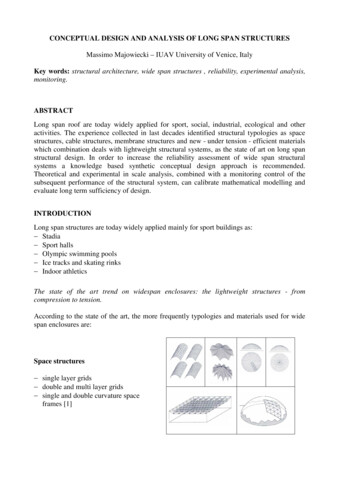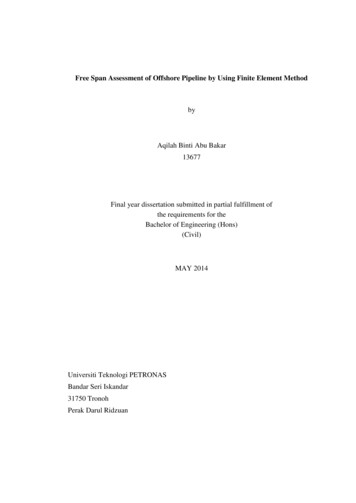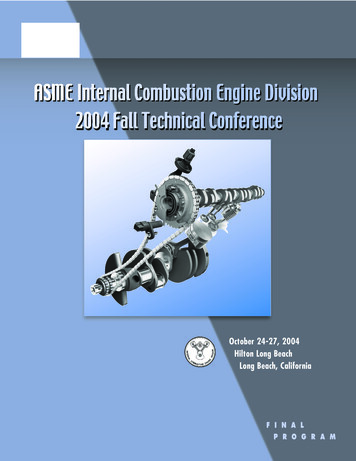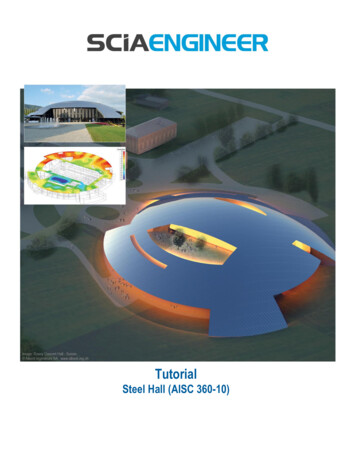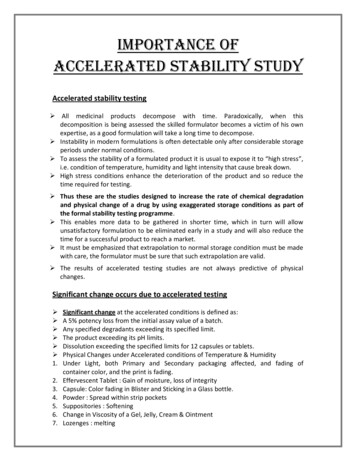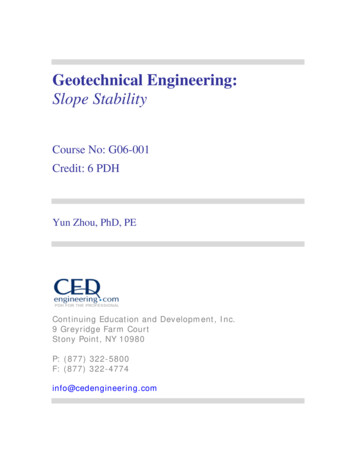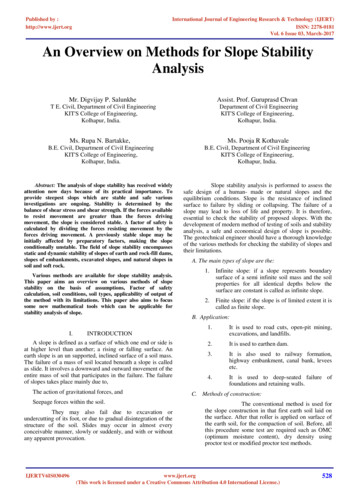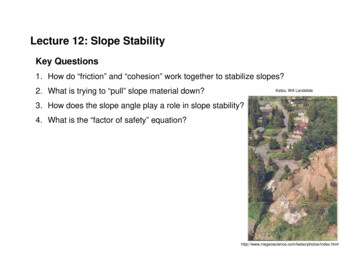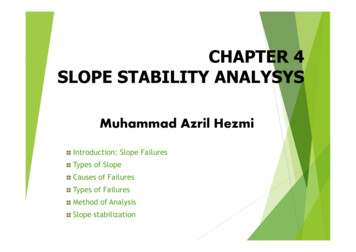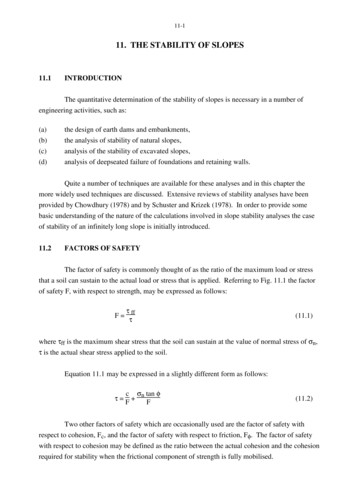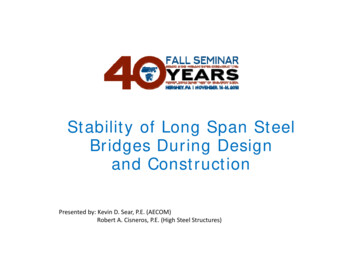
Transcription
Stability of Long Span SteelBridges During Designand ConstructionPresented by: Kevin D. Sear, P.E. (AECOM)Robert A. Cisneros, P.E. (High Steel Structures)
COLLAPSE OF PHOENIX RAILROAD BRIDGE - 1902
COLLAPSE OF QUEBEC BRIDGE OVERST. LAWRENCE RIVER - 1907
COLLAPSE OF TACOMA NARROWS BRIDGE - 1940
COLLAPSE OF ROUTE 69 BRIDGE OVERTENNESSEE RIVER - 1995
STABILITYAs defined by the Merriam-Webster dictionary is“the property of a body that causes it whendisturbed from a condition of equilibrium orsteady motion to develop forces or moments thatrestore the original condition”Another, more bridge specific definition is the lackof undesirable deflections or rotations.STRENGTHAs defined by the Merriam-Webster dictionary is“the quality or state of being strong : capacity forexertion or endurance”Another, more bridge specific definition is the lackof undesirable member stresses.
ECONOMICAL STRUCTURAL DESIGNThe goal is to determine a system where stability isprovided using members that require the leastamount of material above that needed to meetstrength requirements.INSTABILITYCan occur at various stages during the life of a longspan steel girder bridge.Completed Bridge (Responsibility of Designer)Deck Placement (Responsibility of Designer)Completed Framing (Responsibility of Designer)Girder Erection (Responsibility of Erector)
APC FALL SEMINARPART ISTABILITY OF LONG SPAN BRIDGESDURING DESIGN
SR0903 BRIDGE OVER LEHIGH RIVERJIM THORPE, PA
SR0903 BRIDGE OVER LEHIGH RIVERJIM THORPE, PANOTE: STRAIGHT BRIDGENO V‐LOAD ORCENTRIFUGAL FORCES
SR0903 BRIDGE OVER LEHIGH RIVERJIM THORPE, PAHISTORIC CANAL LOCKLEHIGH RIVER
SR0903 BRIDGE OVER LEHIGH RIVERJIM THORPE, PACONCRETE DECKCONNECTION PLATESCROSS FRAMESCOMPLETED BRIDGE STAGE
SR0903 BRIDGE OVER LEHIGH RIVERJIM THORPE, PAWHERE STRESS CAPACITY WAS LESS THAN YIELD USING 25’ CROSS FRAME SPACING, CAPACITY WASINCREASED BY REDUCING CROSS FRAME SPACING TO ABOUT 16.5’.(BOTTOM FLANGE IN COMPRESSION – NEGATIVE MOMENT)COMPLETED BRIDGE STAGE
SR0903 BRIDGE OVER LEHIGH RIVERJIM THORPE, PAWHERE STRESS CAPACITY WAS LESS THAN YIELD USING CROSS FRAME SPACING FROM DESIGN OFTHE COMPLETED STRUCTURE, CAPACITY WAS INCREASED BY REDUCING SPACING TO ABOUT 16.5’.(TOP FLANGE IN COMPRESSION – POSITIVE MOMENT)DECK PLACEMENT STAGE
SR0903 BRIDGE OVER LEHIGH RIVERJIM THORPE, PAWIND LOAD12DIAPHRAGM(TYP)3GIRDER FLANGE(TYP)4STEP 1DETERMINED WIND LOAD PER BD-620M. COMPUTED STRESSES AND DEFLECTIONS IN TOP AND THENBOTTOM FLANGES UNDER SELF-WEIGHT AND WIND LOAD WITHOUT ANY LATERAL BRACING. APPLIED½ THE WIND LOAD TO EACH ANALYSIS. COMPARED STRESSES TO BUCKLING RESISTANCE BASED ONFULL SPAN LENGTH. COMPARED LATERAL DEFLECTION TO L/150 (BD-620M).NOTE – SINCE ALL FIVE GIRDERS WERE IDENTICAL, THEY SHARED THE WIND LOAD EQUALLY. THUS ASINGLE GIRDER WAS ANALYZED AND 1/5 THE WIND LOAD WAS APPLIED.RESULT - LATERAL BRACING REQUIRED (OVERSTRESS BUT ONLY L/215 DEFLECTION OR ABOUT 19”).COMPLETED FRAMING STAGE5
SR0903 BRIDGE OVER LEHIGH RIVERJIM THORPE, PACROSS FRAME (TYP)GIRDER FLANGE(TYP)LATERAL BRACING(TYP)STEP 2DECIDED TO LATERALLY BRACE THE BOTTOM FLANGE. THIS IS THE PREFERRED APPROACH BY BD620M TO AVOID CONFLICT WITH SIP FORM SUPPORT ANGLES AT THE TOP FLANGE.DECIDED TO ADD BRACES IN ONLY ONE BAY. RECOMPUTED STRESSES IN THE BOTTOM FLANGE USINGA TRUSS ANALYSIS AND ONLY TWO GIRDERS. APPLIED ENTIRE WIND LOAD. COMPARED COMBINEDAXIAL-FLEXURE STRESS TO BUCKLING RESISTANCE BASED ON CROSS FRAME SPACING.RESULTOVERSTRESS ELIMINATED THROUGHOUT GIRDERS.DEFLECTIONS REDUCED TO APPROXIMATELY 10% OF THOSE COMPUTED WITHOUT LATERAL BRACING.COMPLETED FRAMING STAGE
SR0903 BRIDGE OVER LEHIGH RIVERJIM THORPE, PAPORTION OF SPAN 3 FRAMING PLANBBBBAAAAAABBLATERAL BRACINGA 6”x6”x1/2”B (2) 6”x6”x1/2”STEP 3DESIGN LATERAL BRACING MEMBERS BASED ON AXIAL FORCE FROM TRUSS ANALYSIS.DETAIL THE CONNECTION BETWEEN BRACING MEMBERS AND BOTTOM FLANGES.NOTE – WT SHAPES ARE BETTER SUITED FOR BRACING THAN DOUBLE ANGLES.COMPLETED FRAMING STAGEBB
PART I ASSESSMENTQuestion: True or False, The goal of economicalstructural designs is to determine a system wherestability requires more material than that neededto meet strength requirements.A – TrueB – False
PART I ASSESSMENTQuestion: True or False, The goal of economicalstructural designs is to determine a system wherestability requires more material than that neededto meet strength requirements.A – TrueB – FalseAnswer: False – The goal is to NOT require morematerial for stability than for strength.
QUESTIONS
APC FALL SEMINARPART IISTABILITY OF LONG SPAN BRIDGESDURING ERECTION
WAYPOINTSREFERENCES:1.PADOT BD 620M (which Kevin has discussed)2.NHI Course3.AASHTO/NSBA S10.1‐2014 Steel Bridge Erection Guide Specification"Those who don't knowhistory are destined torepeat wnloads/catalog/FHWA‐NHI‐130102.pdf
EVALUATE CRITICAL STEPSStart w/visual layout based upon feasible crane placements.As a minimum, the following are typically checked: D W (temp: pick , initial, partial erection) curvature amplification (Mz) as applicable unusual (unique) component loads fbux/ Fnx fbuy/ Fny 1 LRFD fbx/Fbx fby/Fby 1 ( 1.25), ASD cranage & rigging loads splice & CF connections ( 50%, t window) often, global as well as local stability. Shoring, tie-down reactions (vert/lat/longit.) (if applicable) grade/superelev/thermal effects. Bearing fixities (temporary conditions).
“BACK OF THE ENVELOPE” CHECKSCritical stages & load combinations (e.g., D W (temporary)may not be intuitively apparent, even if the structure has asdesigned lateral bracing.What one wants to avoid.For quick hand-checks of a complex analysis, the followingtools have proven handy for the presenter:AASHTO Standard Specifications for Highway Bridges, 17th Edition,Table 10.32.1A :For horizontally curved girders, the lateral torsional effect(“roll”) is amplified, but may be approximated as an initialcheck as shown.For constructibity checks, LUC/bFC 85 ( 90 if analyzed)LUC/RTTDTTDMUNBAL Miyi where : M y,i wiliy TTD temporary tie-down (LTB)
HAVE A SPREADSHEETAASHTO LRFD 6.10AASHTO 17TH ed SLD (check only)This spreadsheet must check Mn for a given unbraced length: Lateral torsional buckling (LTB)Flange local buckling (FLB)Occasional web‐bend buckling (WBB)
CASE STUDIESCase StudyStructureMaxSpanType1SR 903 Lehigh Co. PA335 ft4‐span Multi‐girder2SR 6026/322 Centre Co. PA332 ftMulti‐girder w/Temp LB3SR 322EB/SR6220 Centre Co. PA275 ft2‐span Multi‐girder (R 1,900 ft)4I‐495/I‐95/I‐390, Fairfax Co. VA300 ftContinuous, curved multi‐girder5NY Rte 270 over Erie Canal, NY305 ftThru Truss6I‐95/I‐695, Towson Md (Ramp GG)260 ftContinuous, curved mult‐girder [Q&A]
CASE STUDY I: JIM THORPE, PA
LB OPTION USED
FIELD SPLICE RE‐DESIGNSeveral iterations were performed coordinating with Designer & PADOT etc.Purpose: jobsite conditions (including archaeological historical significance).
Shipping Calculationswere performed tocheck: Axle Loadings Geometry (height) Lb & FbX Y ( Mn)
Erection Stabilityanalysis was performedto check: Crane capacities (picks) Lb & FbX Y ( Mn) UT Bridge validation of STAAD
CASE STUDY II: CENTRE CO. PA
S.R. 6026 OVER S.R. 322CENTRE COUNTY, PAAs abandoned:LOH 100 ft X 1 FT Y 1 FTStability 60mph At completion (longest, curved steel girder span in PA):Length: 1,000 ftThree Span (300ft – 330 ft – 270 ft) continuous unitRadius: 1,900 ftDepth: 10’-9”Spacing: 9’-9”RIGHT‐SIZED, ADJUSTABLE SHORING TOWERS CAN FACILITATE ALIGNMENTCONTROL AS ERECTION PROGRESSES.
INITIAL STABILIZATION
LATERAL ADJUSTMENT (CONT’D)
CASE STUDY III: PORT MATILDA, PAA) LATERAL STAYS (SHOWN HERE STABILIZING PRE‐BD 620M TYPE PASTRUCTURE, CENTRE COUNTY PA)B) SHORING TOWER FOR VERTICAL LOAD/DEFLECTION PERFORMANCE (SHOWNADJACENT TO DISTINGUISHED GENTLEMEN AT CENTRE COUNTY, PA STRUCTURE)
ERECTION ON FALSEWORK
TEMPORARY BRG CONDITIONSFor longer spanbridges, temporarybearing alignment& securementagainst differentialthermal conditionsis important, aswell as the abilityto jack into finalposition.
ERECTION ON FALSEWORK
CASE STUDY IV: I‐395/495/95 VA
STABILIZING LONG‐SPANSL 300 ftW 100 TonsLift height 100 ft
CASE STUDY V: BUFFALO, NYIBC 10‐49Roll‐in/Float‐in of a Prefabricated Truss Bridge47Launching of NY Rte 270 (Campbell Blvd) over the Erie Barge Canal
IBC 10-49 NY Rte 270 Truss Launch over Erie Canal (Continued)ABC: Truss launch sequence(SCHEMATIC)LOLOSOUTH SHORE (ROLL‐IN) LAUNCH SEQUENCELOERIE CANAL CHANNEL CROSSINGThe truss was analyzed using RISA3D for D WSThe falsework was designed per AISC ASD. (Ftgs AASHTO/ACI).
IBC 10-49 NY Rte 270 Truss Launch over Erie Canal (Continued)LONORTH SHORE ROLL‐INLOLOAD TRANSFER (L2‐L8), FINAL ROLL & JACKING DOWN TO FINAL POSITIONBathymetric survey was performed, bc the bargehad a bluff stern & raked bow. Draft, freeboard &metacentric considerations were addressed.
L10L830% D IL6L0L470% D ILOAD TRANSFER FROM L4‐L6 (50%/50%) TO L4‐L8 (ON BARGE)View from South Shore:Load transfer to bargeView from North Shore:Crossing channelView from North Shore:Truss lands on ending falsework (load transfer from barge)
CASE STUDY VI: I‐695/95, TOWSON MD
IT’S QUIZ TIME!!! 250 ft spans R 1000 ft 1st girder line held for stabilityErected, propped cantileverQuestion: when checking the stabilityof an I‐girder during erection, whatare four good criteria for the bridgeerection engineer to evaluate:Answers:1) LTB (AASHTO LRFD 6.10.8.2.3)2) FLB (AASHTO LRFD 6.10.8.2.2)3) WBB (esp deep, slender webs)4) Web crippling/yielding (brg points)
QUIZ TIME (CONTINUED)QUESTION: what are the first TWO things that youshould do when starting an erection stabilityanalysis for a longer span multi‐girder bridge?ANSWERS:1) ID critical erection sequence stages2) Determine unbraced lengths Lb (AASHTO 6.10.8.2.3)
QUIZ TIME (CONTINUED)QUESTION: what are THREE things that you shouldcheck after the girders have been stabilized on thepiers & abutments?ANSWERS:1) Temporary tie‐down reactions/uplifts2) Temporary bearing conditions (fixities)3) Lateral/longitudinal reactions to falsework headers (in addition to gravity)
Thanks for your attention. QUESTIONS ?Fort Belvoir –Mulligan Road ProjectsFairfax Co. VirginiaUS Dept of Transportation (FHWA)Contractor: American InfrastructureErector: High Steel Structures, Inc.So we want to push this thingover that-away, right?AUTHOR (S) NAME (S)& LOGOJockeying girders into position.
AASHTO Standard Specifications for Highway Bridges, 17th Edition, Table 10.32.1A : For horizontally curved girders, the lateral torsional effect (“roll”) is amplified, but may be approximated as an initial check as shown. For constructibity checks, L UC /b FC 85 ( 90 if analyzed) What one wants to avoid. “BACK OF THE ENVELOPE” CHECKS M UNBAL M i y i where : M y,i w i l i y .
